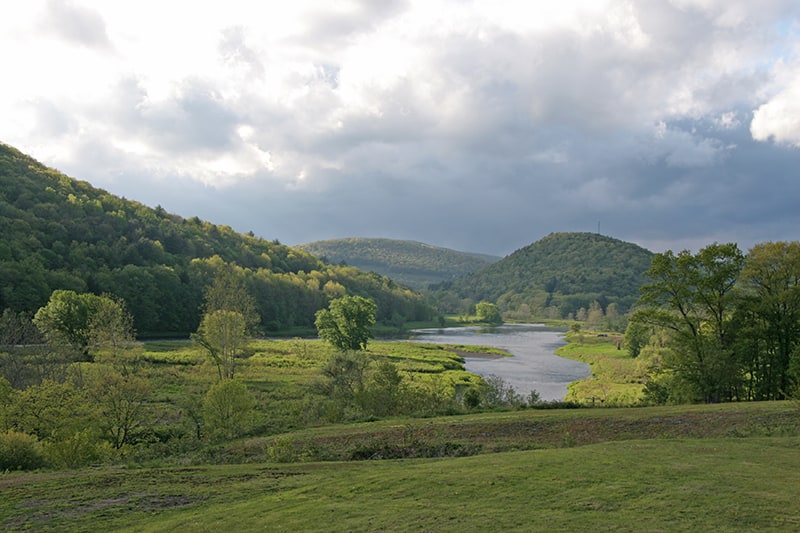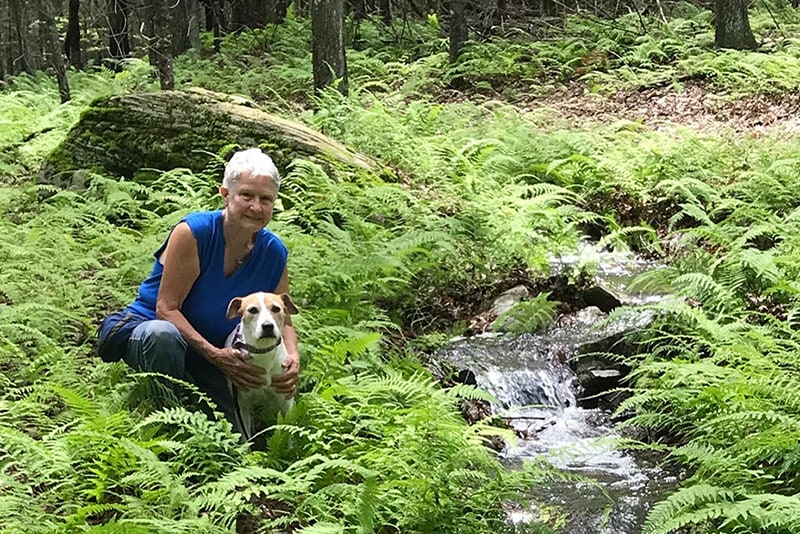Strengthening Your Relationship… With Your Land
– Kenna Knapp
A fenced area 8 feet wide and 100 feet long may seem like a strange design choice, but it keeps the deer out of the apple orchard—and is just one of the many examples of how Kenna and Walt Levendosky have found creative ways to live in harmony with their land.
For many landowners, a relationship with the land is just like any other relationship in life—it requires an investment of time and effort, tends to grow and change over the years, and comes with its own set of unique and unanticipated challenges. And, like any healthy relationship, the energy invested is returned tenfold.
Kenna, her sister Karen, and their father Ken Knapp protected their 220-acres of forests and meadows in Delaware County, New York in 2002. The sprawling 29-room historic homestead on the property, built in 1797, once belonged to attorney Samuel Sherwood, a congressman during the James Madison administration. Kenna and her family have owned it for three generations, since moving from Wyoming in 1944.
Though they had numerous offers to develop the land, the family refused them all, deciding instead to work with the Delaware Highlands Conservancy to place a conservation easement on the property. Located on the West Branch of the Delaware River, the forests help to ensure that the water quality in the river—upstream of New York City’s Cannonsville Reservoir, a source of drinking water for millions—remains pristine. And the great blue herons and bald eagles that roost in their tall, healthy hemlock trees have safe habitat.
Now, Kenna and her husband Walt live on the property, and are finding that stewarding the land—or, more accurately, sharing a love of the land—is a way of life.
Women and Their Woods
Kenna, who has attended two Women and Their Woods (WaTW) retreats, explains, “I think the whole family has to be involved in caring for the land—and women are at the heart of the family. They often spend the most time with the children, they get them outdoors—one of our granddaughters got into the woods and said ‘Oh, this is much better than the house!”
At the WaTW retreats, Kenna learned about various forest management practices and made helpful contacts with other landowners and professionals—Jim Finley, professor of forest resources at Penn State, helped them come up with their unique fence design for the orchard. Deer won’t jump into such a narrow space, fearing it’s a trap. “Using this method, we have completely avoided deer damage!” Kenna explains.
The land gives in return
Protected lands also offer abundant opportunities for proactively making improvements. Their 30 by 80 foot vegetable garden is room enough for dozens of plants that the family enjoys all year. For pollinators like butterflies and bees who rely on a variety of native flowering plants, the Levendoskys have planted bee balm, milkweed, thimbleberries, and goldenrod in their flower garden and orchard, and have installed nesting chambers for native bees in the form of bamboo tubes lined with parchment paper. To restore and stabilize their steep riverbank—the site of an old railroad track that is beginning to erode—they are planning a big planting project with native seed mixes and saplings, including silver maple, beech, and yellow birch.
But a strong relationship with the land also means appreciating nature for its own sake. As Kenna writes of observing the changing seasons, “In winter, snows blanket forests, fields, streams; white silence broken only by cross-country skis sliding through snow crystals. Full moon casts long shadows on lawn and meadows. Late January early morning brings the aroma of maple syrup boiling in a partitioned arched pan mounted over red hot wood coals. As morning awakes, sun rises overhead accelerating the metronome of sap striking metal buckets. We ride through the woods on a bobsled carrying us and a 500 gallon collection vat. Like honeybees, we move from maple tree to tree gathering crystal-clear sap into buckets hung from wooden yokes. Down at the sap house, syrup boils thicker and thicker, passing to end of boiling pan where it drains out a spigot, through cheesecloth into gallon cans or onto snow to congeal as jack wax.
“Spring floods pile up huge cakes of ice, blocking river’s flow as children lie alongside the Little Delaware collecting fish frozen in ice—to take home for the cats. Ice jams break up or are dynamited. Spring floods signal end of ice and snow as we shoot over rapids past giant whirlpools.
“Before leaf canopy opens in late April, forest soils erupt with spring beauties; white, pink and purple hepatica; trout lilies; wood violets; jack-in-the-pulpits; Dutchmen’s breaches; squirrel corn and carpets of bright green leaks. Once sugar maples begin to leaf out, syrup turns dark, spiles are pulled and sapping is over. In late Spring, fishing season begins in earnest. We work rich soils and plant beginnings of vegetable gardens.
“In Summer, we celebrate the river in all its facets. Children build ponds in river’s edge and impound captured minnows there. We pursue native brook trout and rainbows in smaller streams and brooks in anticipation of delicious pink meat. Evenings we fish quiets waters for bass from rowboats fashioned by hand.
“Early Fall brings a harvest of blackberries, blueberries, apples for canning and freezing. In late September-early October, from high on woodland ledges, we view landscapes transformed to a sea of red, maroon and gold. As one of the children exclaims, ‘There is SO much to do here!’”
Deciding to protect a cherished piece of land is only the beginning of a lifelong relationship. To care for the land, it is necessary to connect to it—to observe patiently, to spend time wandering, to learn from others, and to be willing to try and see what works and what doesn’t. To truly steward the land is to strike a careful balance among resolving any problems that arise, finding opportunities to make improvements that will also benefit nature and wildlife, and taking time to appreciate it for its inherent beauty and value.











